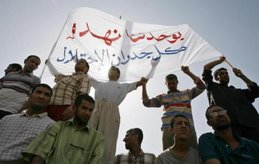Where Is Iraq Heading? Lessons from Basra
Middle East Report N°67 25 June 2007
EXECUTIVE SUMMARY
Amid the media and military focus on Baghdad, another major Iraqi city – Basra – is being overlooked. Yet Basra’s experience carries important lessons for the capital and nation as a whole. Coalition forces have already implemented a security plan there, Operation Sinbad, which was in many ways similar to Baghdad’s current military surge. What U.S. commanders call “clear, hold and build”, their British counterparts earlier had dubbed “clear, hold and civil reconstruction”. And, as in the capital, the putative goal was to pave the way for a takeover by Iraqi forces. Far from being a model to be replicated, however, Basra is an example of what to avoid. With renewed violence and instability, Basra illustrates the pitfalls of a transitional process that has led to collapse of the state apparatus and failed to build legitimate institutions. Fierce intra-Shiite fighting also disproves the simplistic view of Iraq neatly divided between three homogenous communities.
Lack of attention to Basra is understandable. Iraq’s future is often believed to depend on Baghdad, and most of the spectacular bombings have taken place in the centre of the country, far from the southern city. Observers, by now accustomed to the capital’s dynamics, have had difficulty making sense of Basra’s and so have tended to downplay them. Finally, because U.S. forces have not been directly involved, news coverage has been both limited to Arabic and British media and forced to compete with the gruesome violence that is tearing the centre apart.
But to neglect Basra is a mistake. The nation’s second largest city, it is located in its most oil-rich region. Basra governorate also is the only region enjoying maritime access, making it the country’s de facto economic capital and a significant prize for local political actors. Sandwiched between Iran and the Gulf monarchies, at the intersection of the Arab and Persian worlds, the region is strategically important. Sociologically, Basra’s identity essentially has been forged in opposition not only to the capital but also to other major southern cities such as Najaf and Karbala. For these reasons, it is wrong either to ignore it or lump it together with an imaginary, undifferentiated Shiite south.
On its face, Basra’s security plan ranked as a qualified success. Between September 2006 and March 2007, Operation Sinbad sought to rout out militias and hand security over to newly vetted and stronger Iraqi security forces while kick-starting economic reconstruction. Criminality, political assassinations and sectarian killings, all of which were rampant in 2006, receded somewhat and – certainly as compared to elsewhere in the country – a relative calm prevailed. Yet this reality was both superficial and fleeting. By March–April 2007, renewed political tensions once more threatened to destabilise the city, and relentless attacks against British forces in effect had driven them off the streets into increasingly secluded compounds. Basra’s residents and militiamen view this not as an orderly withdrawal but rather as an ignominious defeat. Today, the city is controlled by militias, seemingly more powerful and unconstrained than before.
What progress has occurred cannot conceal the most glaring failing of all: the inability to establish a legitimate and functioning provincial apparatus capable of redistributing resources, imposing respect for the rule of law and ensuring a peaceful transition at the local level. Basra’s political arena remains in the hands of actors engaged in bloody competition for resources, undermining what is left of governorate institutions and coercively enforcing their rule. The local population has no choice but to seek protection from one of the dominant camps. Periods of stability do not reflect greater governing authority so much as they do a momentary – and fragile – balance of interests or of terror between rival militias. Inevitably, conflicts re-emerge and even apparently minor incidents can set off a cycle of retaliatory violence. A political process designed to pacify competition and ensure the non-violent allocation of goods and power has become a source of intense and often brutal struggle.
Basra is a case study of Iraq’s multiple and multiplying forms of violence. These often have little to do with sectarianism or anti-occupation resistance. Instead, they involve the systematic misuse of official institutions, political assassinations, tribal vendettas, neighbourhood vigilantism and enforcement of social mores, together with the rise of criminal mafias that increasingly intermingle with political actors. Should other causes of strife – sectarian violence and the fight against coalition forces – recede, the concern must still be that Basra's fate will be replicated throughout the country on a larger, more chaotic and more dangerous scale. The lessons are clear. Iraq’s violence is multifaceted, and sectarianism is only one of its sources. It follows that the country’s division along supposedly inherent and homogenous confessional and ethnic lines is not an answer. It follows, too, that rebuilding the state, tackling militias and imposing the rule of law cannot be done without confronting the parties that currently dominate the political process and forging a new and far more inclusive political compact.
Iraq is in the midst of a civil war. But before and beyond that, Iraq has become a failed state – a country whose institutions and, with them, any semblance of national cohesion, have been obliterated. That is what has made the violence – all the violence: sectarian, anti-coalition, political, criminal and otherwise – both possible and, for many, necessary. Resolving the confrontation between Sunni Arabs, Shiites and Kurds is one priority. But rebuilding a functioning and legitimate state is another – no less urgent, no less important and no less daunting.
Damascus/Amman/Brussels, 25 June 2007
» read media release
Click here to view the full report as a PDF file in A4 format. For more information about viewing PDF documents, please click here. This document is also available in MS-Word format









